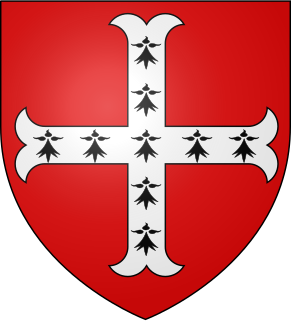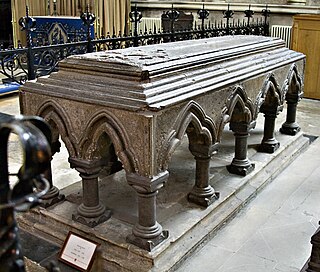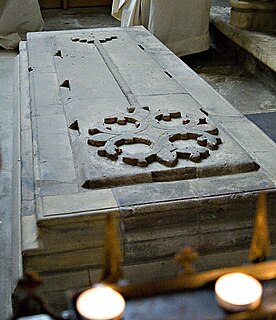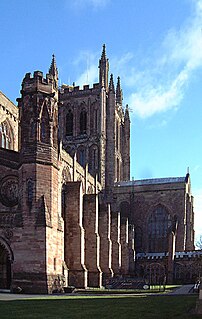Related Research Articles
Robert Burnell was an English bishop who served as Lord Chancellor of England from 1274 to 1292. A native of Shropshire, he served as a minor royal official before entering into the service of Prince Edward, the future King Edward I of England. When Edward went on the Eighth Crusade in 1270, Burnell stayed in England to secure the prince's interests. He served as regent after the death of King Henry III of England while Edward was still on crusade. He was twice elected Archbishop of Canterbury, but his personal life—which included a long-term mistress who was rumoured to have borne him four sons—prevented his confirmation by the papacy. In 1275 Burnell was elected Bishop of Bath and Wells, after Edward had appointed him Lord Chancellor in 1274.
Robert Winchelsey was an English Catholic theologian and Archbishop of Canterbury. He studied at the universities of Paris and Oxford, and later taught at both. Influenced by Thomas Aquinas, he was a scholastic theologian.
Robert of Ghent or Robert de Gant was Lord Chancellor of England and Dean of York in the 12th century. The younger son of a nobleman, Robert was probably a member of the cathedral chapter of York before his selection as chancellor by King Stephen of England in the mid-1140s. He is not mentioned often in documents from his time as chancellor, but why this is so is unknown. He became dean at York Minster around 1147. Robert was slightly involved in the disputes over who would be Archbishop of York in the late 1140s and 1150s, but it is likely that his chancellorship prevented his deeper involvement in diocesan affairs. He was no longer chancellor after the death of Stephen, but probably continued to hold the office of dean until his death around 1157 or 1158.
Walter Giffard was Lord Chancellor of England and Archbishop of York.

Antony Bek was a bishop of Durham and the Patriarch of Jerusalem.
John Kirkby was an English ecclesiastic and statesman.

Sewal de Bovil was a medieval Archbishop of York.

Godfrey Ludham was Archbishop of York from 1258 to 1265.
William de Wickwane was Archbishop of York, between the years 1279 and 1285.
John le Romeyn, died 1296, was a medieval Archbishop of York.
Henry of Newark was a medieval Archbishop of York.

Lawrence Booth served as Prince-Bishop of Durham and Lord Chancellor of England, before being appointed Archbishop of York.
John Blund was an English scholastic philosopher, known for his work on the nature of the soul, the Tractatus de anima, one of the first works of western philosophy to make use of the recently translated De Anima by Aristotle and especially the Persian philosopher Avicenna's work on the soul, also called De Anima. He taught at Oxford University along with Edmund of Abingdon. David Knowles said that he was "noteworthy for his knowledge of Avicenna and his rejection of the hylomorphism of Avicebron and the plurality of forms.", although the problem of the plurality of forms as understood by later scholastics was not formulated explicitly in Blund's time. Maurice Powicke calls him the "first English Aristotelian."
Walter of Kirkham was a medieval English official who held the positions of Keeper of the Wardrobe, Dean of York, and Bishop of Durham. He was elected bishop over Aymer de Valence, 2nd Earl of Pembroke, the brother of King Henry III. As bishop, he was instrumental in the founding of Balliol College in the University of Oxford.
Simon Langton was an English medieval clergyman who served as Archdeacon of Canterbury from 1227 until his death in 1248. He had previously been Archbishop-elect of York, but the election was quashed by Pope Innocent III.
William Langton was a medieval English priest and nephew of Archbishop Walter de Gray. William was selected but never consecrated as Archbishop of York and Bishop of Carlisle.
Stephen Bersted was a medieval Bishop of Chichester.

William of Louth, also known as William de Luda was a medieval Bishop of Ely.

Richard Swinefield was a medieval Bishop of Hereford, England. He graduated doctor of divinity before holding a number of ecclesiastical offices, including that of Archdeacon of London. As a bishop, he dedicated considerable efforts to securing the canonisation of Thomas de Cantilupe, his predecessor, for whom he had worked during his lifetime. Active in his diocese, he devoted little time to politics. He was buried in Hereford Cathedral where a memorial to his memory still stands.
John Salmon was a medieval Bishop of Norwich.
References
- Fryde, E. B.; Greenway, D. E.; Porter, S.; Roy, I. (1996). Handbook of British Chronology (Third revised ed.). Cambridge, UK: Cambridge University Press. ISBN 0-521-56350-X.
- Greenway, Diana E. (1999). "Archbishops". Fasti Ecclesiae Anglicanae 1066–1300. Vol. 6: York. Institute of Historical Research. Retrieved 22 September 2007.
- Greenway, Diana E. (1999). "Chancellors". Fasti Ecclesiae Anglicanae 1066–1300. Vol. 6: York. Institute of Historical Research. Retrieved 22 September 2007.
- Greenway, Diana E. (1999). "Prebendaries: Stillington". Fasti Ecclesiae Anglicanae 1066–1300. Vol. 6: York. Institute of Historical Research. Retrieved 22 September 2007.
- Moorman, John R. H. (1955). Church Life in England in the Thirteenth Century (Revised ed.). Cambridge: Cambridge University Press. OCLC 213820968.
- Prestwich, Michael (1997). Edward I. New Haven, CT: Yale University Press. ISBN 0-300-07157-4.
- Smith, David M. (2004). "Corbridge, Thomas of (d. 1304)". Oxford Dictionary of National Biography. Oxford University Press. doi:10.1093/ref:odnb/6303.(subscription or UK public library membership required)